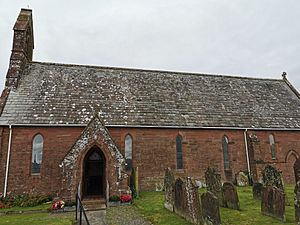St Peter, Drigg facts for kids
Quick facts for kids St Peter, Drigg |
|
|---|---|

St Peter, Drigg
|
|
| Lua error in Module:Location_map at line 420: attempt to index field 'wikibase' (a nil value). | |
| OS grid reference | SD0704099205 |
| Location | St Peter, Drigg, Cumbria |
| Country | England |
| Denomination | Anglican |
| Website | [1] |
| History | |
| Status | Parish church |
| Dedication | St Peter |
| Administration | |
| Parish | Drigg |
| Deanery | Calder |
| Archdeaconry | West Cumberland |
| Diocese | Carlisle |
| Province | York |
St Peter, Drigg is a special old building in a village called Drigg, located in Cumbria, England. It's an active Anglican church, which means it's part of the Church of England. This church is a parish church, serving the local community. It's connected to several other churches in the area, like those in Black Combe, Eskdale, and Irton.
Contents
The Church's Story: History
St Peter's Church has a long history! It was first built by a group of monks called Augustinian monks way back in the 1200s. That's over 800 years ago!
The church you see today was mostly rebuilt in 1850. Workers used stones and wood from the very first church, giving it a connection to the past. When it was finished, it was officially blessed in a special ceremony.
What the Church Looks Like
The church is built from local red sandstone, which gives it a warm, earthy color. Its roof is made of slate, a strong, flat stone. There's a small tower called a bellcote with two bells inside.
Inside the Church
When you step inside, you'll find a large main area called the Nave. There's also a North Aisle and a Chancel, which is the part of the church near the altar.
Some parts of the church are very old! The row of pillars and the eight-sided font (a basin used for baptisms) are from 1292. That means they are over 700 years old!
On the west wall of the Nave, there's a tall, narrow window. Below it, you can see a special plaque.
Stained Glass and Organ
The church has beautiful stained glass windows. They were made by different artists, including one by William Wailes in the East window. These windows tell stories with colorful light.
You'll also find a large organ with 31 pipes. A plaque on the organ says it was given "To the glory of god and to commemorate the 60th year of the reign of her most gracious majesty Queen Victoria." This means it was installed in 1897, celebrating Queen Victoria's 60 years as queen.
The pews, where people sit, are made of dark wood and are fixed in place.
The Churchyard
Outside the church, there's a churchyard with about 200 gravestones. One of these is a special grave for a soldier from the Commonwealth War.

